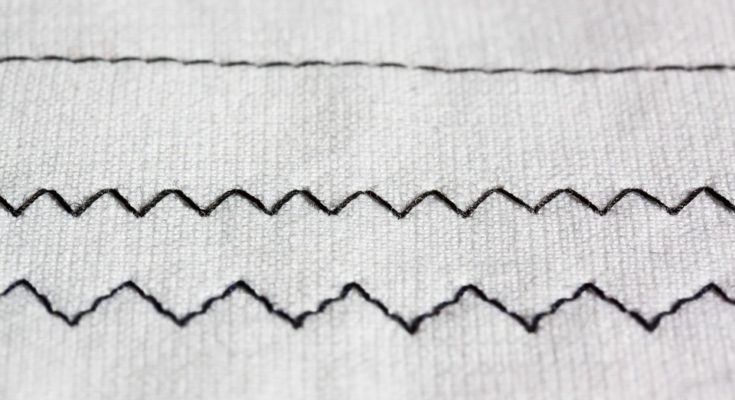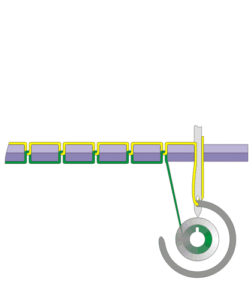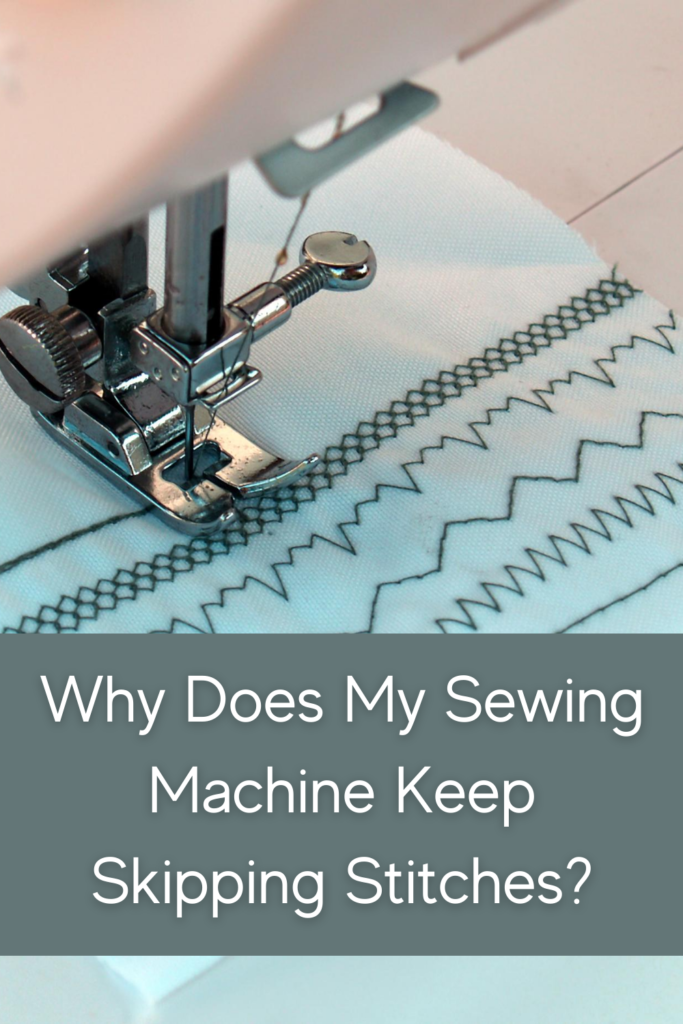Disclosure: This post may contain affiliate links. I earn a small commission when you click a link and make a purchase. Thanks for supporting SewingSociety.com!
Sewing machines create stitches by looping two strands of thread together. If everything does not go right, you will see skipped stitches. Here are eight reasons why your sewing machine can skip stitches, and what to do about each one.
Contents
Your Sewing Machine Is Not Threaded Correctly
Even people who have been sewing for years sometimes thread their sewing machines incorrectly. This is the first thing you should check if your sewing machine is not working properly or your stitches do not look right.
Unthread your sewing machine and rethread it from the beginning. Make sure your thread take-up lever is in its highest position, attach your spool of thread, and then pull your thread through your tension discs and thread guides according to the instructions in your user manual. Then, pull your thread through the eye of your needle and leave a four-inch tail of thread.
Your Thread Tension Is Too Tight
Your thread tension should be adjusted for different weights of fabric and thread. Make sure that you are using the same weight thread in both your bobbin and upper thread. If you don’t, the tension can be uneven and cause skipped stitches.
Sewing machine manufacturers suggest that you don’t mess with your bobbin thread tension too much, but you should adjust your upper thread tension if your thread keeps breaking while you sew. If your tension is too tight, it can pull your thread and break it or skip a stitch. Turn your tension dial counterclockwise to loosen it. If you can’t seem to get your tension right, a sewing machine repair technician can reset your bobbin tension.
Your Thread Is Poor Quality
Thread comes in several weights. Some thread is so fine it will snap from a little pull and some thread is so thick it will break in the eye of your needle or in your tension discs. If you’re using poor-quality thread, that might be the reason why you’re getting skipped stitches. Be careful when choosing thread for your sewing projects. Avoid buying thread in bulk packages because it tends to be poor quality. This thread is fine for hand sewing and small projects, but it might not be strong enough to handle machine sewing.
Your Needle Is Damaged, Bent, or Dull
Over time, your sewing machine needle can get damaged or bent, especially if you are sewing through thick fabric. If your needle gets too bent, it can cause skipped stitches. To avoid bending your needle, try to slow down while you’re sewing or use a sharper needle.
Sewing machine needles also have natural flaws or burs that happen during manufacturing. This means that you will occasionally come across a needle that is bent or damaged before you insert it into your machine. This isn’t very common, but it does happen. It’s a good idea to always have replacement sewing machine needles on hand.
Your Bobbin Is Not Inserted Correctly
Your sewing machine will still form stitches if you insert your bobbin backward, but they won’t look right. If you are seeing skipped stitches, especially after you sew a few good stitches, check to see if your bobbin is inserted properly. Some sewing machines require the thread to go clockwise in your bobbin case, and some require it to go counterclockwise. Check your user manual to see which direction is required for your sewing machine.
You Bobbin Case Is Full of Lint
Lint builds up in your bobbin case as you sew. It can get in the way of your needle and prevent the hook in your bobbin case from forming stitches properly. Clean your sewing machine frequently to prevent skipped stitches.
Your Hook Timing Is Off
When your needle goes down, the hook system on your sewing machine creates a loop to form a stitch. If this does not happen, your hook timing is off. It might show up as skipped stitches. You can check your hook timing by slowly lowering your needle through your needle plate and watching for the moment when it starts to go back up. This is when the loop should form.
You can try to fix the problem yourself or take your machine to a repair technician to have the hook timing reset. This is something that is checked whenever you take your sewing machine in for regular maintenance. You should always turn your handwheel toward you to avoid messing up the timing of your machine.
Your Fabric Is Too Thick
Sewing machines are only designed to handle a couple of layers of fabric at a time. If your fabric is too thick or you’re trying to sew through too many layers at one time, you might get skipped stitches. This is because your needle might not be able to pierce all the way through. If you can’t avoid so many layers, try to slow down as you sew and use a longer stitch length. You can also adjust your presser foot pressure.
Did you find this article helpful?
I can help you solve other sewing machine problems, too! Get a copy of my book, Sewing Machine Problems and How to Solve Them on Amazon.
Your sewing machine is going to give you troubles again.
It’s inevitable…
My troubleshooting book walks you through how to solve the 20 most common sewing machine problems. You’ll be prepared to tackle any problem your sewing machine throws at you. That means more time sewing and less time crying.
The ebook version only costs $2.99. You’d easily pay between $75 and $150 to take your sewing machine to a repair technician. Learn how to do a lot of the sewing machine troubleshooting yourself and save money.
For more information, visit our Sewing Machine Troubleshooting Page.
Share this post on Pinterest!








3 Comments on “Why Does My Sewing Machine Keep Skipping Stitches?”